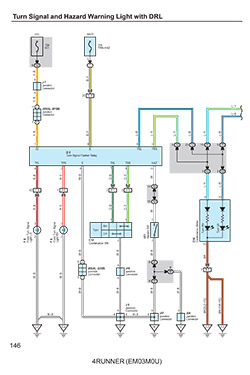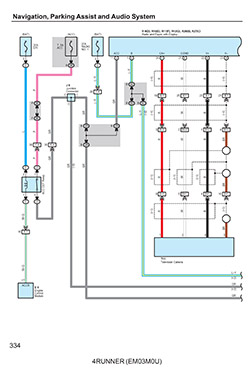|
Main Menu
|
|
|
|
My 2007 4Runner
|
|
|
|
|
|
|
|
|
|
|
|
|
*New*
|
|
|
|
|
|
|
|
|
|
|
|
|
|
|
|
|
|
|
|
*New*
|
|
*New*
|
|
|
|
|
|
|
|
|
|
|
|
|
|
|
|
|
|
|
|
|
|
|
|
|
|
|
|
|
|
*New*
|
|
|
|
|
|
|
|
|
|
|
|
|
|
|
|
|
|
|
|
|
|
|
|
|
|
|
|
|
|
|
|
|
|
|
*New*
|
|
*New*
|
|
*New*
|
|
|
|
|
|
|
|
*New*
|
|
*New*
|
|
*New*
|
|
*New*
|
|
|
4Runner History
|
|
|
|
Other
|
|
|
|
|
Concept:
After performing the Anytime Camera Mod, I noticed reverse camera's wide angle view is useful
while traveling at speed on the highway as a pseudo blind spot monitor.
In the aforementioned mod, I already had installed a switch to activate the reverse / backup camera anytime I wanted, now all I had to do was add the ability for the camera to automatically come on when the turn signals are activated.
What needs to be accomplished:
The factory Toyota navigation setup has a backup camera system that when the vehicle is put into reverse, it automatically sends a video signal from the backup camera housed within the
rear tailgate, up to the nav screen.
A switch will be added to fool the navigation system into thinking the vehicle is in reverse even though we are not. This "anytime backup camera" switch will activate the camera and
automatically force the nav screen to change from whatever is currently being displayed on it (such as maps, audio, etc.), to a direct video feed from the camera.
Utilizing a single pole double throw (SPDT) with on-off-on functionality will allow the following:
ON - activate the camera anytime on demand
OFF - OEM functionality, activate the camera only while in reverse
AUTO - automatically activate the camera anytime a turn signal is used
Building the blind spot monitor module:
We need to build an electronic switching circuit that will fool the navigation system to thinking it is in reverse in two scenarios
1) anytime via a switch or 2) when a turn signal is activated.
In this circuit, one relay will be used to isolate the reverse signal so that it does not back feed into the ecu and fool the nav into thinking it is in reverse.
The other two convert each of the negative turn signal feeds to a positive one and route that to the first relay mentioned above.
Here is the Toyota 4Runner blind spot monitor mod, in schematic form that I created which also shows how it is wired into the factory navigation system.
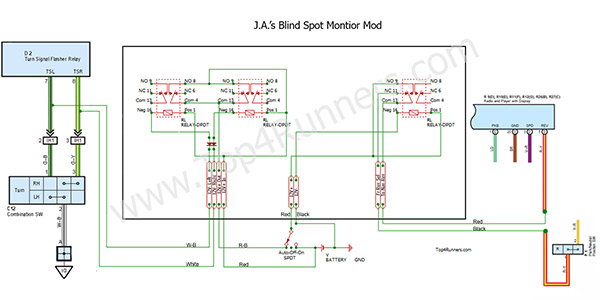
J.A.'s Blind Spot Monitor Schematic |
Since I performed the Anytime Camera Mod and
Nav Video Mod previously, the construction of my blind spot monitor mod (pictured below) is esentially an add on to those mods.
The schematic posted above though is all encompassing, meaning that if you did not already perform the Anytime Camera mod or the Nav Video mod, no worries,
everything is on this schematic to get full functionallity of the Blind Spot Monitor Mod.
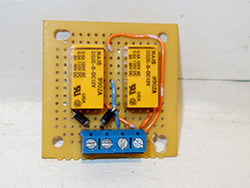
Blind Spot Monitor Mod.
Only two of three needed relays
are here as I have previously completed the
"Anytime Backup Camera Mod"
|
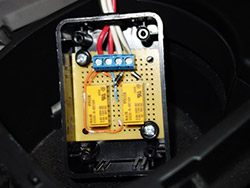
Blind Spot Monitor Mod.
Only two of three needed relays
are here as I have previously completed the
"Anytime Backup Camera Mod"
|
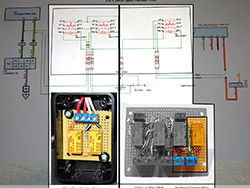
Here you can see the third relay (highlighted)
that in my situation is located elsewhere |
Installing the Blind Spot Montior Module:
Begin by removing navigation unit to access the wiring behind it.
Remove driver side lower finish panel for access to driver side interior relay/junction box.
Start out by disassembling the lower dash area as we need access to the driver side interior relay/junction box. To access this area,
first remove the two 10mm bolts holding the lower finish panel on. Pull the panel straight out to disengage 4 plastic clips still holding it on.
The trim ring around the key hole will just pop out on it's own as you are doing this. Remove the wire harnesses attached to each of the switches
located on the back side of this panel. Also on the back right side of this lower finish panel is the room temperature sensor harness (cooler thermistor),
detach this from the panel as well. You may leave the fuel door release and the hood release handles attached to the panel. The panel can be lowered
to the floor now.
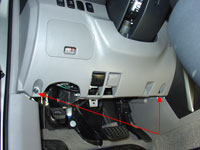
Remove driver side
lower finish panel |
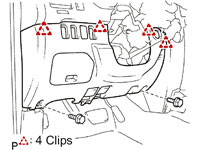
Pull to release 4 clips |
Remove lower bracket:
Remove two 10mm bolts holding the metal bracket around the bottom of the steering column. Disengage the 2 claws and remove the instrument panel lower
left hand bracket. Set bracket aside.
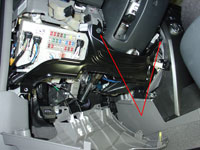
Remove instrument panel
lower bracket |
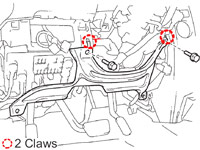
Disengage 2 claws |
Lower down the driver side interior relay/junction box:
Remove wire clip and wire connector under steering column.
Remove three bolts holding driver side interior relay/junction box in place.
Remove bolt & bracket.
Pull down driver side interior relay/junction box to access back side.
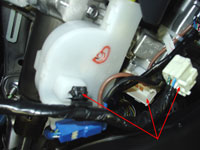
Remove wire clip
and wire connector under steering column |
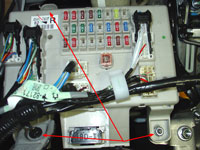
Remove three bolts |
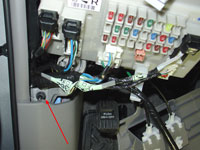
Remove bolt & bracket |
Center Console Removal.
To remove the center console, start by removing the shifter cover. It is held on with five clips and two claws. To remove you simply pull straight
up and back towards the rear of the vehicle. Before you can set the shift cover aside you need to remove any wire harnesses attached to it.
In my case I had to remove the DAC switch wiring and the 12v power point wiring. You may have more if you have the seat heaters,
rear air suspension or cigarette lighter options.
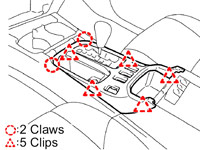
To remove shift cover
Pull to release 5 clips |
Next the console cover gets removed, this time there are 6 clips and two claws. To remove, again, pull straight up and back towards the rear of the
vehicle.
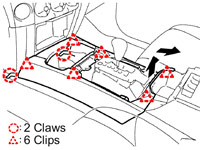
To remove console cover
Pull to release 6 clips |
Before you can lift out the center console itself, you need to remove the upper panel side garnish. To remove, unclip the side covers just in front of
and below the cupholders. Then slide rearward to remove.
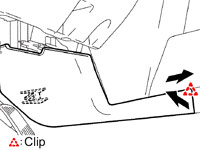
To remove side garnish
Pull to release 1 clip |
Then using a 10mm socket, remove the six bolts holding the console in place.
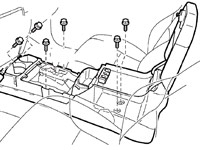
Remove six 10mm bolts |
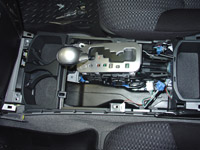
Bolts removed |
Disconnect 4 more harnesses (automatic transmission shift lever illumination, accessory input for stereo, 115v power point and cup holder illumination),
then lift out entire console and set aside.
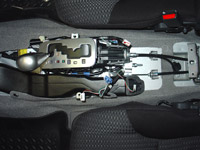
Lift out center console |
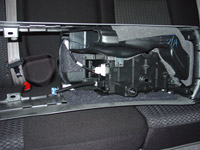
Set console aside |
Center Instrument Cluster Removal.
To remove the center instrument cluster, start out by opening the storage bin under the climate control assembly.
Using a 10mm socket, remove the one bolt that is in there.
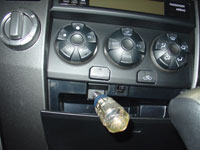
Using a 10mm socket |
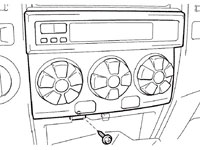
Remove bolt |
Disengage the 4 clips and remove the air conditioner assembly, and then disconnect the wiring connector on the back.
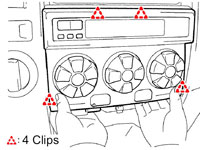
Pull to release 4 clips |
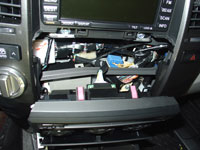
Pull forward and disconnect wire harness |
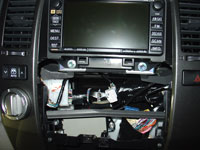
Climate control assembly removed |
Now you can remove the center instrument cluster finish panel sub-assembly. First remove 3 bolts using a 10mm socket.
Then disengage the 8 clips. At this point you can disconnect the three wire connectors from the hazard lights, rear window control and 4WD selector.
Set the panel aside.
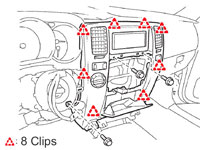
Remove 3 bolts
Pull to release 8 clips |
Using the 10mm socket, this time with and extension bar, remove 4 bolts holding in the navigation unit. Pull the navigation unit straight out. In order to work on the wiring, you will
need to disconnect the 9 wire harnesses on the back side. Then set the navigation unit aside.
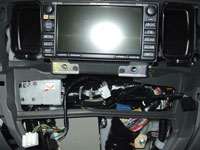
Center instrument cluster finish panel removed |
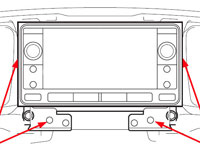
Remove 4 bolts
Pull navigation unit straight out |
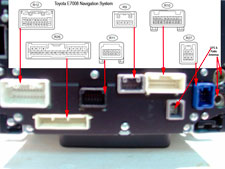
Remove 4 bolts
Navigation connectors |
Wire Connections:
With the navigation unit out of the dashboard, it is time to splice our module into the factory wiring.
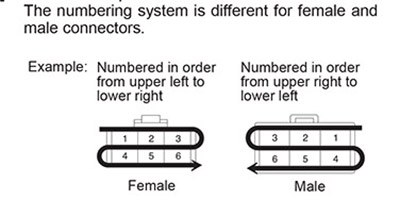
Pin Numbering System |
Relay One:
Identify and cut in half the backup camera trigger wire which is the red wire with yellow stripe located at pin5 in the R9 connector.
Run a wire from the connector side of the cut wire to the common prong of the first of three relays (pin 30 or 13).
Run the other side of the wire to the normally closed prong of the relay (pin 87a or 11).
Run a ground wire to one side of the relay coil (pin 86 or 16).
Run switched 12V+ to the other side of the relay coil (pin 85 or 1).
Also run switched 12V+ to the normally open prong of the relay (pin 87 or 9).
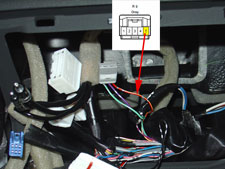
Backup camera trigger wire identified |
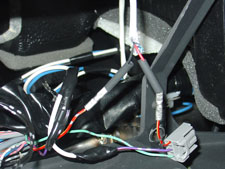
Splice made at reverse cam trigger wire
ready to heat shrink |
Relay Two and Three:
Tap into the turn signals. Locate D2 Connector on Daytime Running Light & Turn Signal Flasher Relay which is mounted on the back of the driver side interior relay/junction box.
Identify Pin #7 (left turn signal) green with black stripe wire and #8 (right turn signal) green with yellow stripe wire.
These are the wires that turn signal stalk use to a send a ground signal to the Daytime Running Light & Turn Signal Flasher Relay.
Cut these wires in half, one inch from the connector. Connect a length of 18awg (American wire gauge) wire to each of the cut sides and run this wire from here to where you will mount the blind spot monitor module.
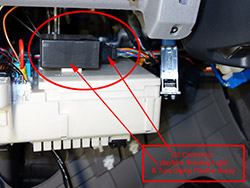
DRL Relay
Connector D2 |
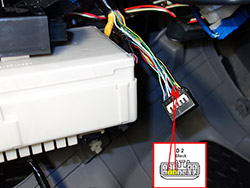
Pin #7 and #8 |
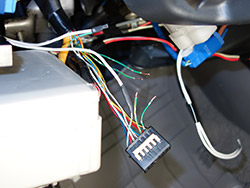
Cut #7 and #8 |
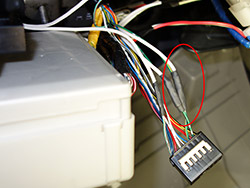
Splices completed |
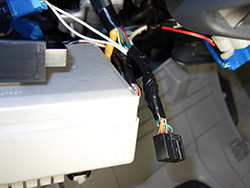
Wire bundle
taped up |
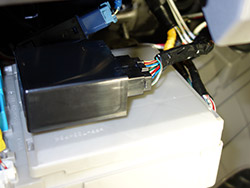
Wire bundle
reconnected |
Install Switch:
A 12V SPDT switch is needed for this mod.
I used a round rocker switch that matches the one I used for my Navigation Override and Unlock Bypass Mod.
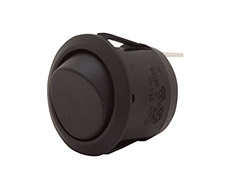
Round rocker switch |
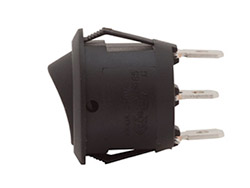
Round rocker switch |
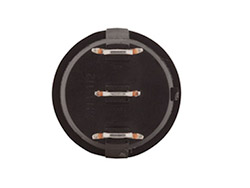
Round rocker switch |
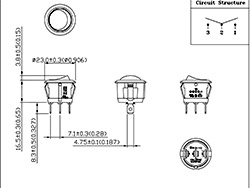
12V round rocker
switch info |
Switch information:
12V SPDT Round Rocker Switch. Del City.
Switch Type: Rocker Switch
Circuitry: Single Pole Double Throw (SPDT)
Terminals: 3 standard male brass blades, 0.187" wide x 0.327" long (4.75mm x 8.3mm).
Up Position: On (2-3).
Middle Position: Off.
Down Position: On (2-1).
Electrical Rating: 6 amps at 250V AC, 10 amps at 125V AC
Illuminated: No.
Housing: Black plastic bezel and actuator.
Mounting Panel snap-in.
Panel Thickness: fits panels 3mm max thickness.
Mounting Hole Dim. Inch 0.775" (19.8mm).
Bezel Size: 0.906" (23.0mm).
I decided to locate the switch that activate this mod on the blank panel right behind the cupholders. I found a nice 12V round rocker switch that only required
a simple 3/4" hole to be drilled for installation. This switch fits perfect and is low profile enough that it allows the bin under the radio to open fully without interfering
with the switch. I used 3/4" washers to layout the spacing and check for clearance before drilling.
I am using this panel to house multiple switches for various mods. So the pics that follow so me installing multiple switches all at once.
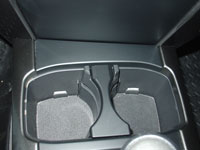
4Runner center console
cupholder area |
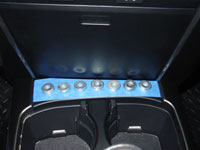
Laying out switch panel |
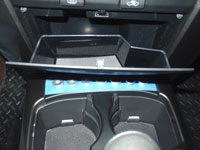
Checking for clearance |
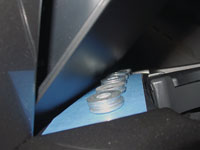
Checking for clearance |
You will notice I'm installing three of these switches in total.
This panel will hold between five to seven switches depending upon the spacing used between them.
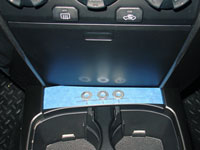
Drawing the drilling pattern |
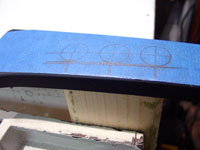
Preparing to drill |
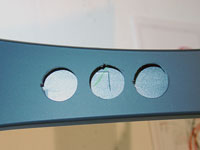
Holes for switches drilled
switch notches carved |
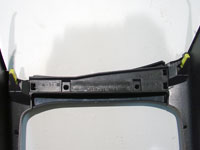
Underside of center console |
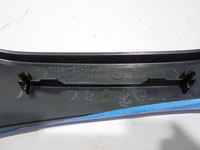
Panel support |
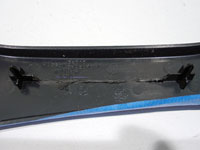
Panel support removed |
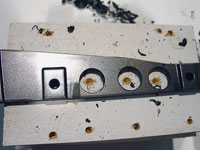
Support panel drilled |
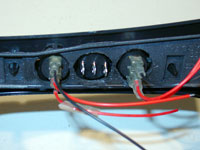
Switches mounted |
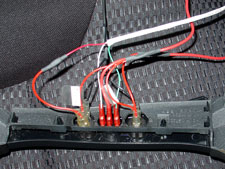
Switch panel wired up |
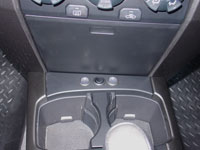
Round rocker switches |
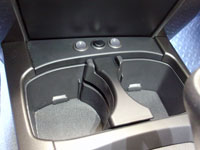
Switches installed |
After completing the installation of the relay module, associated wiring and switch, reinstall the navigation system back into dash.
Results:
While I relaize that there will be naysayers who insist that this is a useless mod if you set your mirrors correctly, from my perspective this is a very low cost, "fun" mod, done as an add-on to the
already performed anytime camera mod to simply show just what can be done with some inventive ingenuity.
The Anytime Reverse Camera feature can be quite useful while towing and wanting to check on the hitch connection.
The Blind Spot Monitor function is useful at high speeds when wanting that extra assurance that no one is in the area that your rear and side view mirror are not quite capturing.
The mod can also be turned totally off for city driving when using the navigation's directional guidance feature and you dont want to have the screen change automatically to the reverse camera
while navigating an unfamiliar area with many turns.
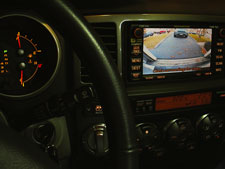
Anytime reverse camera
shown while in park |
|
|

